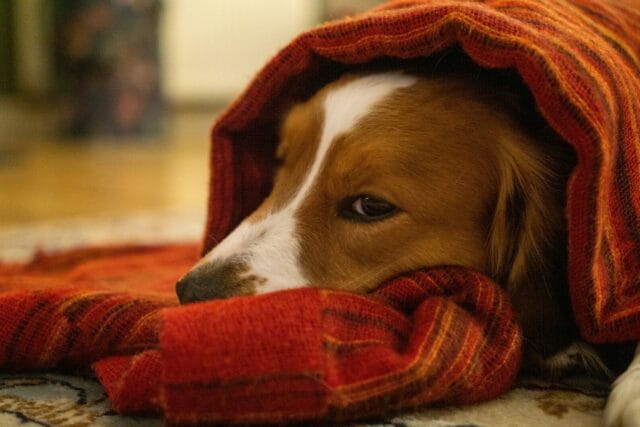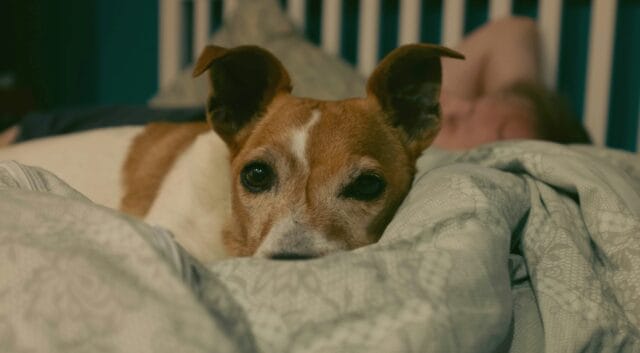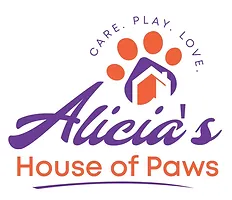Fireworks can be a highly stressful time for many dogs, especially those who are already nervous. At AHoP, we believe we don’t just walk dogs, we build their confidence. And that means helping our canine friends feel safe, secure and supported when things get noisy and unpredictable. Here are a range of strategies grounded in positive-reinforcement, behavioural knowledge and sound environment management to help your dog through firework nights.

Understand the Why
Loud booms, flashing lights and unpredictable bursts can trigger a dog’s “flight, fight or freeze” response, are a significant welfare issue in dogs and can pose a danger to little humans too.
Signs your dog is worried may include: trembling or shaking, hiding, panting, lip-licking, pacing, tail tucked, attempting to escape, inability to engage in play, refusing food or treats, wide eyes or ‘whale eyes’, and generally showing frenzied behaviour or a lack of movement depending on your dog.
Some dogs may show worry very physically with fast movement, while others may shut down and be very still. Consider your dog’s normal behaviour, and compare to their current behaviour to determine if they are showing signs of stress. Also keep in mind that their hearing is much better than ours, even if you don’t hear any fireworks, they may be able to.
Understanding this helps set the foundation for supporting them calmly and positively.
1. Prepare a Calm, Safe Space
Crate-training has a moment to shine here. If your dog is already used to a crate, this step will be easier. But even if they are not crate-trained, this is the first step we would recommend to every dog owner even if your dog doesn’t use it right away.
Creating a dedicated “den” for your dog helps them feel in control and safe, it gives them a consistent place to retreat to, where, if respected by the humans in the household, your dog knows they won’t be bothered and they can take some time to themselves to calm down.
Choose a quiet room or corner of the home, away from direct sight of fireworks or street noise.
You can use a crate or open-door kennel and cover it with some blankets to reduce light and create a den-like feel, but keep the front of the crate clear to allow for air-flow. If your dog likes to bury themselves, a bed with a tent is an excellent choice, or layer with a few blankets that they can bury themselves in.
Close windows, blinds and curtains to block the light and dampen the noise, switch on a soft light so flashing outside light is reduced and to create a calm atmosphere.
Play low-volume calming music or background sound. A study by The University of Glasgow and the Scottish SPCA found that dogs prefer soft rock or reggae overall, this resulted in calmer dogs all round. But play around with different genres and see if your dog has a favourite kind of music. You could also give white noise a try, or brown noise which is a bit deeper in tone.
- Some dogs like a thunder shirt, it’s a top that wraps tightly but evenly around your dog’s chest giving the feeling of a comforting hug. You can do something similar with a scarf, but consider your dog’s personaility. Some dogs find physical touch over-stimulating, in which case a thunder shirt would be a bad idea, where as other take comfort in physical touch – perfect candidates for a thunder shirt.
- Provide favourite toys, a comfortable bed, and a lickimat or puzzle toy filled with safe tasty food. Giving your dog something to focus on (especially something they “work for”) helps support calm behaviour. Remember, chewing, licking and sniffing are naturally calming for dogs. Which ever is your dog’s preference, indulge that as much as possible. Put their meals in to a puzzle feeder, or lickimat if it’s wet, so they are practicing these three behaviours as much as possible. Do this for every meal, not just when fireworks are on. Keep that stress bucket as empty as possible.
For example, offer a lickimat with a spread of peanut butter or yoghurt, or a puzzle feeder with kibble served slowly.
The act of licking or solving a puzzle can be inherently soothing and occupies their brain/body in a positive way. Giving them a little win, something they can do and succeed at boosts their dopamine just as it does in humans.
2. Masking & Desensitisation
Start playing music and background sound before the fireworks begin to give the dog a chance to settle.
Consider playing firework‐sound recordings at very low volume well in advance (days or weeks) paired with positive experiences (treats, puzzles, calm petting) – this is desensitisation + counter-conditioning in dog training terms.
Each evening: keep background music or TV on, so that sudden bangs are less pronounced. The Dog’s Trust have a playlist for doggies which has been tested in their shelters and resulted in dog’s spending more time chilling or even sleeping.
Monitor your dog’s volume and body language, if they appear stressed or escalate, reduce volume, switch to a calmer activity or add in an easier puzzle-feeder, calmer strokes or no strokes depending on your dog’s response to touch, engage them in something easy like a few tricks they know well, or try switching to another area of the house.

3. Games-Based and Reward-Based coping
Puzzle toys & lickimats: Fill a lickimat with something safe and tasty (e.g. little yoghurt, canned dog food, smear of peanut butter) and let them lick and explore. The licking action is calming, and the amusement distracts them from external noise.
Interactive play or very gentle training: A short session of a fun cue your dog knows (e.g. “touch”, “paw”, “look”) in the safe space helps channel energy into a positive interaction rather than fear.
Associate firework sounds with good things: If you play low-volume firework recordings and immediately give a treat or start a fun puzzle toy when the sound plays, you’re helping your dog build the association: “that noise = something good happens”. This is classic counter-conditioning.
Remain calm, use a positive tone, and never punish fearful behaviour, that simply adds more stress to the situation and teaches your dog that they cannot come to you for comfort or support.
4. Use Calming Aids Sensibly
While the focus is positive reinforcement and environment/support rather than just “quick fixes”, certain calming aids can be helpful as part of a layered strategy:
Calming sprays/diffusers such as Animology’s Paws & Relax Aromatherapy Dog Spray. This can help reduce the baseline anxiety and support the other methods. I use this spray for my dog at home, and we use it in the dog vans, it’s simply lavender essence and is approved for use directly onto the dog’s coat and we see some improvement when it has been freshly sprayed.
A calming collar, or anxiety wrap may provide some comfort. Some owners report these can help, especially in more anxious dogs. Tofu the Corgie shows you how to make one using a scarf here.
Food supplements or herbal remedies can be supportive, but they should not replace the training, environment and preparation we describe here. Always check with the vet. I use Rescue Remedy and believe I have seen some benefit in my dogs and cats, so it’s worth adding into your dog’s water during the firework season, assuming no health issues or contraindications.
If the fear is severe, causing your dog to defecate/urinate inappropriately, or becoming aggressive towards people or animals they know well, please consult your vet or a qualified behaviourist – sometimes behavioural therapy or medical support may be needed.
5. Prepare well before the event
Walk earlier: Take your dog for a good calm walk in daylight, before fireworks begin. This helps burn off energy and gives them a chance to relieve themselves.
Secure home and garden: Ensure gates, windows and doors are secure. A spooked dog might bolt in fear, make sure your dog’s microchip and tag details are up to date…juuustt in case. If you’re looking for a secure playground to exercise your dog without the worry of them bolting, have a look at our doggy playground to hire near Dalkeith, EH22.
Avoid schedule surprises: If you know fireworks are likely (Bonfire Night, New Year’s Eve, local firework displays) plan ahead. Have your safe-space ready.
Keep routine: If possible keep as much of your dog’s normal schedule as you can (meals, play, rest) as familiarity helps lower general anxiety.
Set expectations realistically: Progress may take time. If your dog has a long-standing noise fear, you may need months of gentle work. Do this every year and hopefully you’ll see some improvement. If not, at least you know that you have done everything you can to help.
6. On the night: what to do
Go to the safe space, turn on the background music, provide the lickimat/puzzle toy, calmly encourage them to settle.
If your dog wants comfort (coming to you, cuddling), that’s great, don’t feel you must ignore them. There is only so much you can do, but, you can be present with them, so they aren’t coping alone.
Avoid forcing your dog out or penalising fear behaviours (e.g. don’t scold them for hiding, trembling or refusing to go to the toilet outside). That will only increase their discomfort as now they know you are upset with them.
After the fireworks, allow your dog to decompress slowly. Keep the safe space available for a while afterwards, have a chill few days to allow your dog to gain confidence at their own pace. Maybe your dog bounces right back and is excited to go the park – perfect! Just go at their pace.
Monitor for signs of trauma or continuing anxiety (e.g. shaking, pacing, refusal to settle). If this continues, seek professional guidance.
7. Post-season and long‐term work
Use the quiet days after fireworks to reinforce calm behaviours: short play/training sessions, positive experiences, low‐stress walks.
If you played firework‐sound recordings at low volume ahead of time, gradually increase the volume as your dog shows calm responses (always paired with reward) to build resilience. Always start a session at a low volume, increase every few minutes by a small amount if your dog is doing well – i.e. not showing any signs of stress. This is the desensitisation & counter-conditioning path.
Consider including noise-handling (sound exposure) as part of your general training regime: even outside fireworks season, use very low volume firework/thunder recordings + high-value reward to build lifelong confidence.
Keep celebrating small wins: each time your dog approaches their den, uses their puzzle toy, remains relaxed during a bang – mark it, reward it, celebrate it.
Final thoughts
Firework season doesn’t have to be a time of dread for your dog (or for you). With patience, preparation and a positive-reinforcement approach, you can significantly reduce your dog’s stress and help them feel safe, calm and confident. At AHoP, we believe deeply in “confidence through connection” and gentle, fun, structured support. Your dog’s safe space, their lickimat, the soft music, the training games – they all come together to form a toolkit of trust. We like to think of it as the perfect time for some TLC, cosiness and movies together.

